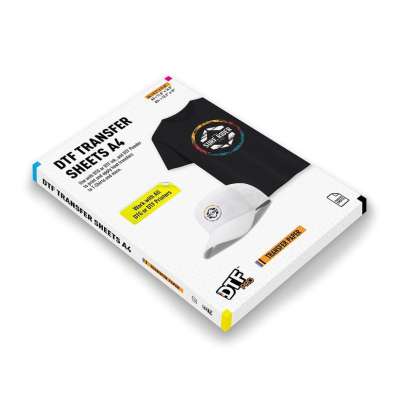DTF PreTreat Sheets - work with all DTF printers utilizing DTF ink and DTF PreTreat Powder.
Available Brands/Finish:
| Premium |
|---|
 |
- Back-side is matte
- The matte back looks similar to the coated printable side - so extra care is needed to identify the printable side
- The matte back helps minimize static issues, in high static environments
- Warm Peel (allow to cool for at least 10-15 seconds before peeling from the shirt)
|
| $7.99 |
Available Matte Options:
Revolutionary Technology - DTF PreTreat Sheets - works with all DTF printers on the market! The process of heat transfer of textile ink to the film can be done on a variety of fabrics such as cotton and polyester. When printing using a DTF or DTG printer, you will first need to print to the DTF sheets / film. Then, add DTF powder to cover the print before curing. Wear protective masks when operating your DTF equipment and processes and operate in a well ventilated room with a filtration system.
What are DTF PreTreat Sheets, technically speaking?
DTF PreTreat Sheets are also referred to as DTF sheets or DTF transfer film. They are a specially formulated polyethylene terephthalate (PET) release film. If that was a mouthful, don't worry, here is what you really need to know:
How do I use DTF PreTreat Sheets?
DTF TRANSFERS are created using DTF PreTreat Sheets (DTF Transfer Sheets), and DTF PreTreat Powder (DTF Transfer Powder).
First, you print (using your DTG or DTF machine, with DTG ink or DTF ink) to DTF Sheets or DTF Rolls; then cover your print with DTF Powder; and heat press it to your Garments or Textiles. You can either print in COLOR, for transfer to WHITE textiles, or you can print 1 layer of COLOR then 1 layer of WHITE, if you're transfering to DARK / BLACK textiles.
But what's the benefit of DTF (Direct to Film) if the purpose of DTG is, by definition, Direct To Garment, and with DTF you're introducing a transfer sheet?
Traditional transfer printing been around for ages, and specifically used in the heat transfer or sublimation print markets. So what are the benefits of DTF over other heat transfers? There are a few actually, and they are significant:
- DTF allows for transfers to dark shirts (due to white DTF ink) - something regular heat transfers can't do
- DTF results in more breathable prints, smooth to touch, and flexible - something regular heat transfers can't do
- DTF does not require cutting out the image on the transfer - something regular heat transfers can't do
- DTF results in more vivid colors than heat transfers
OK, so the above shows the substantial advantages that DTF offers over HEAT TRANSFER (or even SUBLIMATION).But what benefits does DTF have over DTG?
Well there are 2, and they are also substantial:
- DTF eliminates the need for PRETREATMENT! No more extra pretreatment / chemical steps for your dark shirt prints. Eliminate the hassle of pretreatment by using DTF PreTreat Powder and DTF PreTreat Sheets
- DTF allow you to get your printed images to MANY MORE materials and substrates (Lycra, cotton, nylon, swimsuit fabrics, high-elasticity fabrics, chemical fiber or shoes , hats, bags etc)
And best of all, PROFESSIONAL DTF's PROFESSIONAL DTFducts work with all DTF printers and engines!
RELATED / RECOMMENDED ITEMS: